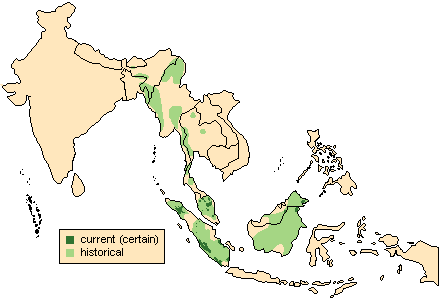![]() Return
to Perissodactyla
Return
to Perissodactyla
Classification
|
 Dicerorhinus
sumatrensis
Dicerorhinus
sumatrensis
Sumatran rhinoceros
![]()
Taxonomy
 |
 |
 |
Click on the pictures above for a larger view of the
photographs
|
||
General Characteristics
Body Length: 240-315 cm / 8-10.5 ft.
Shoulder Height: 135 cm / 4.5 ft.
Tail Length: 50 cm / 20 in.
Weight: 1,000 kg / 0.8 ton.The leathery hide is gray-brown in colour, and is folded into armour-like plates. Unique among rhinos, the Sumatran rhinoceros is covered with a conspicuous coat of coarse, reddish brown hair. The body is relatively short and stocky, and the pillar-like legs are short. Two horns are found on the nose in both sexes, with the front horn growing larger than the rear. Males' horns usually larger than those in females. The upper lip is hooked and prehensile.
Ontogeny and Reproduction
Gestation Period: 477 days (N=3 at the Cinxinnati Zoo).
Young per Birth: 1
Weaning: At 18 months.
Sexual Maturity: Females at 4 years, males at 7 years.
Life span: 35 years.
Ecology and Behavior
The Sumatran rhinoceros feeds just before dawn and after dusk and moves during the night. During the day, it relaxes in mud wallows and ponds. These wallows are usually created by the animals, with the surrounding 10-35 meters kept clear, and used as a resting place. Seasonal movements have been recorded, with animals moving to higher elevations during the rainy season, and down to the valleys during the cooler months. They can maneuver on steep slopes with skill, and can swim well - having been spotted venturing into the surrounding sea. Sumatran rhinos are dependent on salt-licks, with populations based around them. Around one of these licks, the population density was 13-14 animals per square kilometer. Home ranges of adult males average 30 square kilometers, with the edges overlapping extensively. Females have smaller ranges, with the average size being 10-15 square kilometers. Both sexes mark their ranges with scrapes, excrement, and bent saplings.Family group: Solitary.
Diet: Leaves, twigs, shoots, fruits, with an average consumption of 50 kg of food a day.
Main Predators: Humans, tigers.
Distribution
Tropical rainforests in restricted pockets in Indonesia.

Range Map (Redrawn from Foose and van Strien, 1997)
Conservation Status
The Sumatran rhinoceros as a species is classified as critically endangered by the IUCN (1996). However, D. s. lasiotis is believed to be extinct, and both D. s. harrissoni and D. s. sumatrensis are considered critically endangered.
Remarks
Di- from dis (Greek) two, double; keras (Greek) the horn of an animal; rhis (Greek), genitive rhinos, the nose: a reference to the two horns on the nose. -ensis (Latin) suffix meaning belonging to; this rhino is not confined to Sumatra, and even once ranged through south-eastern Asia.
Literature Cited
Foose, T. J., and N. van Strien [editors]. 1997. Asian Rhinos - Status Survey and Conservation Action Plan. Gland, Switzerland, and Cambridge, UK: IUCN. Available online at http://www.rhinos-irf.org/technicalprograms/asrsg/index.htmNowak, R. M. [editor]. 1991. Walker's Mammals of the World (Fifth Edition). Baltimore: The Johns Hopkins University Press.
Schenkel, R. 1990. Asiatic Rhinoceroses. In Grzimek's Encyclopedia of Mammals. Edited by S. P. Parker. New York: McGraw-Hill. Volume 4, pp. 635-642.
Wilson, D. E., and D. M. Reeder [editors]. 1993. Mammal Species of the World (Second Edition). Washington: Smithsonian Institution Press. Available online at http://nmnhwww.si.edu/msw/
Return to Perissodactyla

![]()
© Brent Huffman, www.ultimateungulate.com |
|
|